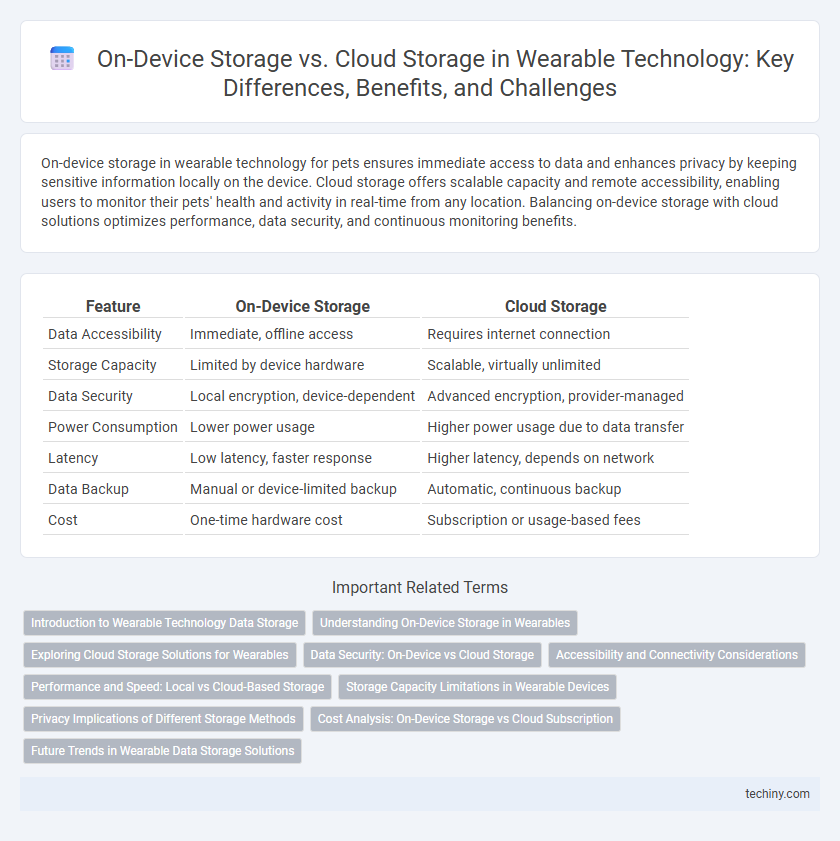On-device storage in wearable technology for pets ensures immediate access to data and enhances privacy by keeping sensitive information locally on the device. Cloud storage offers scalable capacity and remote accessibility, enabling users to monitor their pets' health and activity in real-time from any location. Balancing on-device storage with cloud solutions optimizes performance, data security, and continuous monitoring benefits.
Table of Comparison
| Feature | On-Device Storage | Cloud Storage |
|---|---|---|
| Data Accessibility | Immediate, offline access | Requires internet connection |
| Storage Capacity | Limited by device hardware | Scalable, virtually unlimited |
| Data Security | Local encryption, device-dependent | Advanced encryption, provider-managed |
| Power Consumption | Lower power usage | Higher power usage due to data transfer |
| Latency | Low latency, faster response | Higher latency, depends on network |
| Data Backup | Manual or device-limited backup | Automatic, continuous backup |
| Cost | One-time hardware cost | Subscription or usage-based fees |
Introduction to Wearable Technology Data Storage
Wearable technology data storage is critical for managing the vast amounts of information generated by sensors and user interactions. On-device storage offers immediate access and enhanced privacy by processing data locally, minimizing latency and reducing dependency on internet connectivity. Cloud storage, in contrast, provides scalable capacity and remote accessibility, enabling seamless data synchronization and advanced analytics across multiple devices and platforms.
Understanding On-Device Storage in Wearables
On-device storage in wearable technology enables data to be saved directly within the device, allowing for faster access and enhanced privacy compared to cloud storage. This local storage is crucial for real-time processing of health metrics such as heart rate, step count, and sleep tracking without relying on continuous internet connectivity. Limited capacity often requires efficient data compression and selective synchronization with cloud services for long-term analysis and backup.
Exploring Cloud Storage Solutions for Wearables
Cloud storage solutions for wearable technology enhance data accessibility and security by offloading storage demands from limited on-device memory to scalable, remote servers. These solutions support real-time syncing, enabling seamless access to health metrics, activity logs, and multimedia files across multiple devices while reducing the risk of data loss due to device damage or loss. Leading cloud providers like AWS, Google Cloud, and Microsoft Azure offer optimized APIs and edge computing capabilities, ensuring low latency and efficient data processing tailored for wearable applications.
Data Security: On-Device vs Cloud Storage
On-device storage in wearable technology offers enhanced data security by minimizing exposure to external networks and potential cyber threats, ensuring sensitive information remains physically within the user's control. Cloud storage provides scalable capacity and facilitates seamless data synchronization across devices but requires robust encryption protocols and access controls to safeguard against breaches and unauthorized access. Wearable devices increasingly implement hybrid solutions combining local encryption and secure cloud authentication to balance security with accessibility and storage efficiency.
Accessibility and Connectivity Considerations
On-device storage in wearable technology ensures immediate data accessibility without relying on internet connectivity, making it ideal for use in remote or offline scenarios. Cloud storage offers extensive capacity and seamless synchronization across multiple devices, but requires stable and continuous internet connections. Balancing on-device storage for critical, low-latency access with cloud storage for large-scale data backup optimizes both accessibility and connectivity in wearables.
Performance and Speed: Local vs Cloud-Based Storage
On-device storage in wearable technology offers faster data access and reduced latency compared to cloud storage, enabling real-time performance critical for health monitoring and fitness tracking. Cloud storage, while providing extensive capacity and seamless data synchronization across devices, often experiences delays due to network dependency and bandwidth limitations. Prioritizing local storage enhances immediate responsiveness and operational efficiency in wearables where speed is essential.
Storage Capacity Limitations in Wearable Devices
Wearable technology faces significant storage capacity limitations due to the compact size and energy constraints of on-device storage, often restricting the amount of data that can be directly saved. Cloud storage offers virtually unlimited capacity and facilitates real-time data backup, but it depends on reliable network connectivity and may introduce latency in data access. Balancing between limited on-device memory and cloud-based storage solutions is crucial for optimizing performance and user experience in wearable devices.
Privacy Implications of Different Storage Methods
On-device storage in wearable technology offers enhanced privacy by keeping sensitive data such as health metrics and location information directly on the device, reducing exposure to potential breaches associated with data transmission. Cloud storage, while providing scalability and seamless data access across multiple devices, introduces risks including unauthorized access and data interception during transfer. Implementing strong encryption protocols and user-controlled access settings is critical to safeguarding personal information regardless of the chosen storage method.
Cost Analysis: On-Device Storage vs Cloud Subscription
On-device storage in wearable technology involves a one-time hardware cost but limits data capacity, while cloud storage requires ongoing subscription fees scaling with usage and data retention needs. Cost analysis reveals that on-device storage offers predictable expenses and offline accessibility but may lead to higher initial investment and maintenance. Cloud subscriptions provide scalability and remote access without hardware upgrades, yet cumulative fees can surpass the cost of physical storage over extended periods.
Future Trends in Wearable Data Storage Solutions
Future trends in wearable data storage solutions emphasize enhanced on-device storage capacities using advanced non-volatile memory technologies such as MRAM and ReRAM, reducing latency and improving privacy by minimizing reliance on cloud infrastructure. Edge computing integration in wearables enables real-time data processing and analytics while offloading critical information to hybrid cloud frameworks for scalable storage and backup. Emerging standards in 5G and 6G connectivity will further optimize seamless synchronization between wearable devices and cloud platforms, driving innovations in personalized health monitoring and augmented reality applications.
On-Device Storage vs Cloud Storage Infographic

 techiny.com
techiny.com